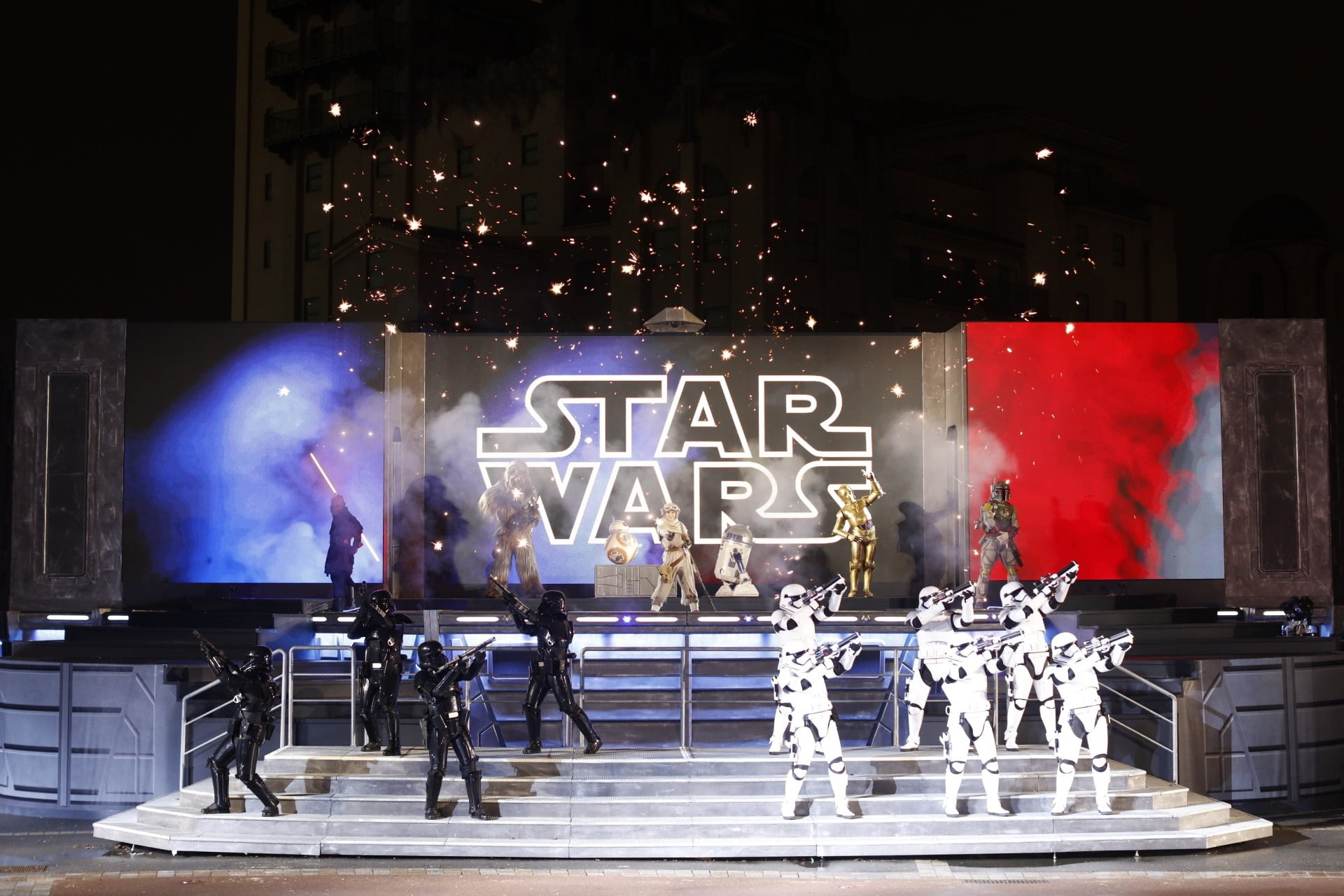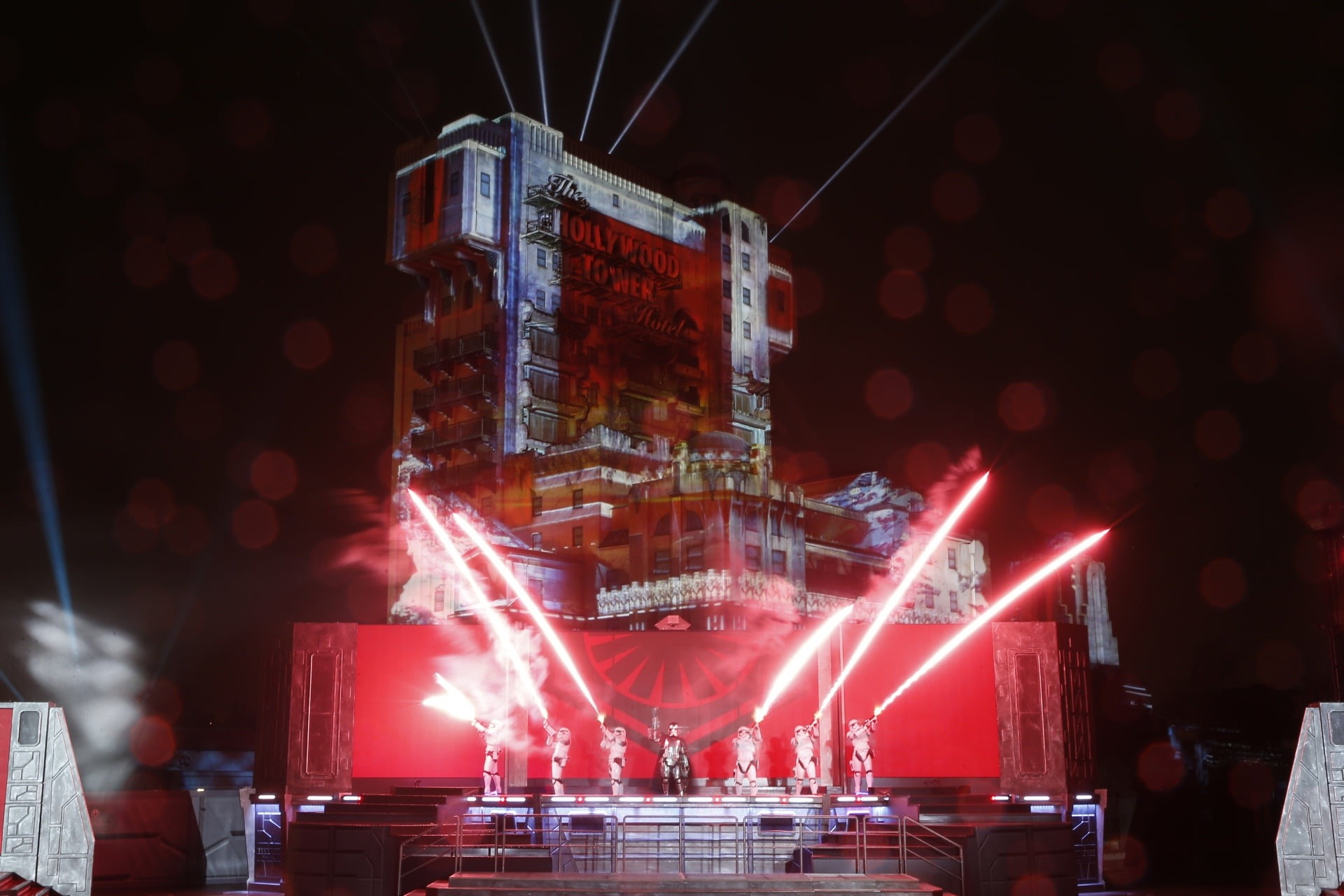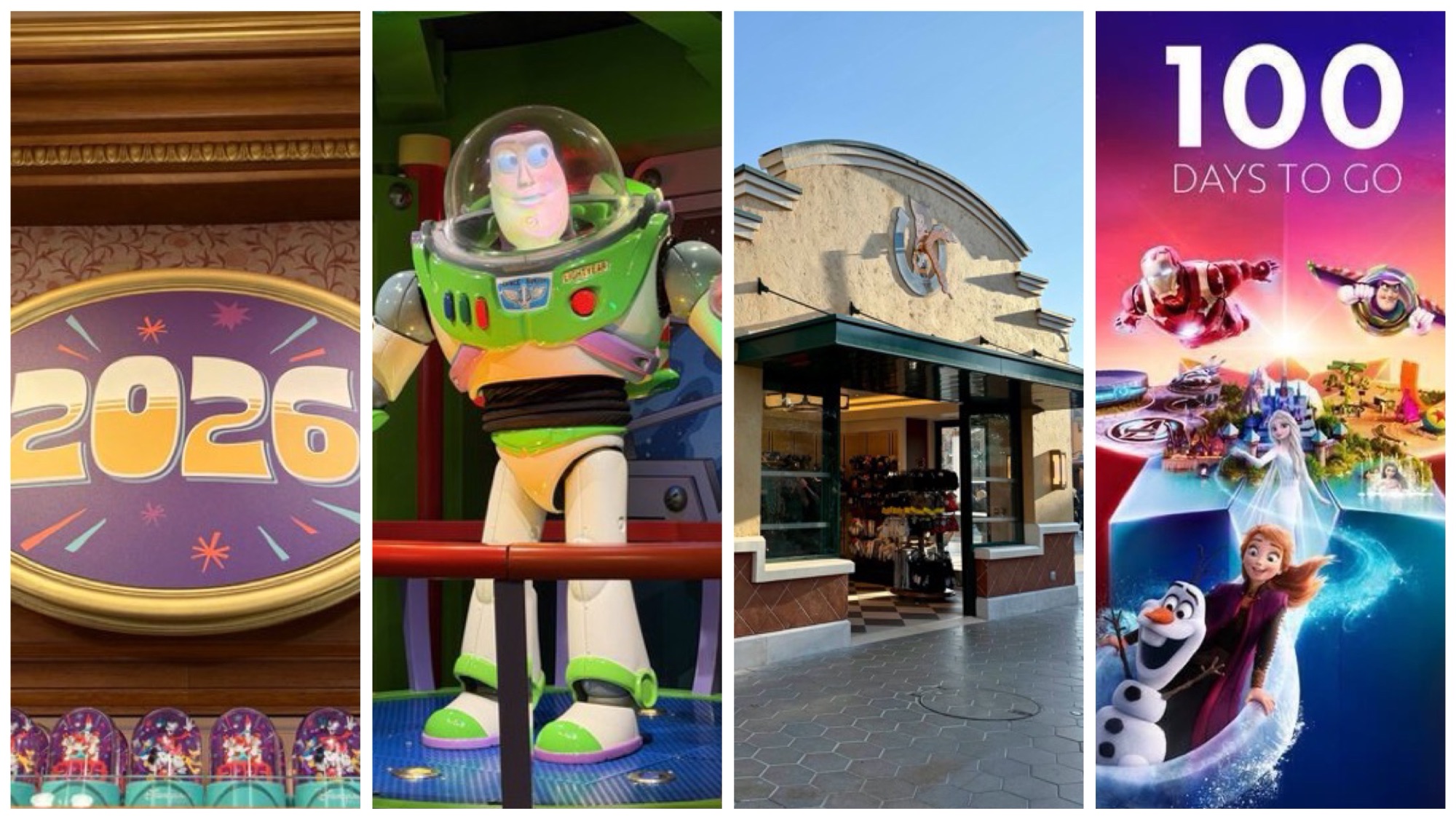« A Galactic Celebration » resumes on January 11, 2020 at Walt Disney Studios Park, on a unique stage at the foot of the Tower of Terror, and with impressive technical tools. The Insidears team met up with the producer of the show, Marie-Charlotte Bientz and the stage manager, Michael Mulato.
Marie-Charlotte, Michael, how did you come to work on Star Wars: The Galactic Celebration?
Marie Charlotte: I joined the company 12 years ago now. I had studied show production at university and Disneyland Paris was my work-study company during my Masters. I was fortunate to be hired as a production assistant thereafter and have grown from there to my current position. Disney Dreams! was the first show I worked on when I joined the production trade. This is where I met Michael. And following this experience, I was asked to participate in the development of the production infrastructure for Production Courtyard, as well as in the Star Wars: A Galactic Celebration show which uses, like Disney Dreams!, video projection.
Michael: As for me, I arrived at Disneyland Paris fifteen years ago. I started by working on the attractions, then I went to the parades department where I accompanied the Disney Characters and I guided the floats. Two years later, I became assistant stage manager. Between 2007 and 2017, I participated in most of the destination’s shows. Then I became stage manager for productions such as Bienvenue à la Belle Saison (2014) or La Garden Party de Dingo (2016). For almost a year, I was stage manager on Disney Dreams! before becoming general stage manager almost three years ago. I worked as such on the different seasons of Disneyland Park – Christmas, Halloween, … – as well as the special events. I participated in the opening of the first Pirates & Princesses Festival and I have been the stage manager of the Production Courtyard stage at the foot of the Tower of Terror for over a year now. I take care of all the shows that take place there like #Surprise Mickey, Legends of the Force or The Season of Marvel Super Heroes.
Michael, what is your job on this particular show?
M: As stage manager of this scene, I am the operational manager of everything that happens there. Once the show is in operation, that is to say after the production phase piloted by Marie-Charlotte, I direct all the trades working on it, with the help of my team of stage managers, in order to coordinate the whole.
Can you tell us more about this very special stage?
MC: We created it to be able to present shows as part of the different seasons of Walt Disney Studios Park, as well as for big one-off events such as Electroland. So it had to be very flexible. LED screens are a very important technical element of this device as they allow them to be played day and night. Basically, at first we only had one main screen, then we made extensions and we now have three screens that allow real immersion. Then we added two new scenes with their own screen, courtyard and garden as we say in the middle of the show. In the end, all these screens can play simultaneously, both in panning and individually. This is something that we exploit a lot on Star Wars: A Galactic Celebration since we mainly rely on movies.

General rehearsal, January 9 2020
Beyond this stage, there is also the whole “mapping” dimension, notably on the facade of Tower of Terror..
MC: The goal was to be able to offer nightly shows at Walt Disney Studios Park in the same way as those in Disneyland Park, knowing that The Tower of Terror is the tallest building in the whole destination, with a mapping surface (for projection) quite unique.
Our infrastructure was designed in much the same way as that of Disneyland Park, especially since the same teams operate at both parks and it was important that they have common tools and benchmarks. However, between Disney Dreams! and the premiere of Star Wars: A Galactic Celebration, almost four years passed during which technology leapt by leaps and bounds. Walt Disney Studios Park has logically benefited from these advances.
M: To carry out these projections, we have 17 video projectors, including 16 in « quadrial », that is to say that we have four video projectors projecting the same image on a given area (against two in Disneyland Park), which allows more power and light for an even more spectacular rendering. In addition, the Tower of Terror offers a much larger and much flatter surface than Sleeping Beauty Castle, which means that several important scenes can be projected at the same time, on several areas of the Tower. As for the 17th video projector, it is used to dress the rest of Production Courtyard such as the Terrasse Perrier, so as to immerse visitors even more in our story.
Indeed, visitors do not just face the show, they are truly immersed in the adventure. And it’s not just the pictures. Sound is also an essential parameter of this immersion.
MC: What’s also unique about this stage is the 360 ° sound. That is to say that you have a sound diffusion on the front, therefore oriented towards the public as you can have on any big concert, but there is also a system of diffusion in 7.1 distributed all around the space that allows us to create particularly immersive effects. For example, when a ship is projected on the Tower of Terror, you have the sound of its engine which is spatialized all over the place and you really have the impression that it is passing just above you .

Star Wars: A Galactic Celebration combines many different means of expression: the stage with the characters, the video, the projections, the sound, not to mention the visual effects and pyrotechnics. How is it all synchronized?
M: Everything is coordinated by a « time code », a kind of very precise stopwatch, like on most major current shows, and all the effects, whether video, lasers and pyrotechnics, are programmed from this count. For example, we know that at 12 minutes, 3 seconds and 10 frames, there must be such an effect, and so on throughout the show.
MC: And this time code is guided by music. Audio is the conductor of all of our shows. Natalia Beliaeva, the director of Star Wars: AGalactic Celebration, has a great musical sensitivity. This is felt in the way he stages characters and images. It comes from movement, from music. And music flows from video, lasers, light and pyrotechnics. We were particularly attentive to the way of combining all these elements around the music. On Star Wars, it is all the more important that the score of John Williams is very, very rich and offers a lot of possibilities. The magic of this show is to carry the audience in a movement, to give them the impression, while being static, of flying towards this distant galaxy, very distant.
How did you work with the different directors of the show?
MC: Our goal in production is to make the dreams of our directors come true. But at the same time, with our experience and the knowledge of the technical teams we work with, we can guide them, give them the skills to go even further. This is production for me: being attentive to the director but at the same time making him discover other creative possibilities. In Star Wars: A Galactic Celebration, this manifests itself particularly in terms of interactions with our droid friends. The director’s wish to have some of the saga’s droids and robots in the show influenced the design of the stage, but starting from there, reflecting on our side on how to welcome these robots on our stage, we managed to get even more robots to come. This is how we have C-3PO and R2-D2, but also BB-8, and the droid sequence has become much more important than it was at the start.
From its creation in 2017 until the launch of this new season, the show has changed significantly.
MC: This show is five years of my life! And things have happened! I think first of all of the creation of this unique stageand the pharaonic work that it represented. And the show then evolved thanks to the scenic deployment I was talking about earlier, to the work done to make the device even more immersive. With five screens now, we can broadcast even more images. This new device also offers more stage space, which means that all of our characters have even more possibilities for interaction with the public. And suddenly there are more.
And then, each new episode brings its share of novelties. For The Rise of Skywalker, the timing was very tight as the film was recently released. But we also had to close the saga in our own way. That’s why we’ve properly integrated a tribute to Episode IX this year.

General rehearsal, January 9 2020
The reactions of the audience are also a source of inspiration for you.
MC: The warm reaction from visitors is extremely important to us. We are also very attentive to comments posted on the internet and on fan sites. When we are lucky enough to have a season like this, which comes back from one year to the next, we try to take it into account to improve ourselves, and to also fulfill the dreams of certain fans.
M: For most of the shows I worked on and therefore Star Wars: A Galactic Celebration, we spend weeks or even months working upstream in meetings, and especially in rehearsals, to see and review the show every night . But on the premiere day, it’s not the show I’m watching anymore, but the audience. This is a very strong moment, which we look forward to.
What is your favorite moment from this Galactic Celebration?
MC: I’ll say the arrival of Darth Vader, which is truly magical. He comes out of the shadows and we just see his saber lighting up in the dark before he reveals himself to us. Iconically, it’s very strong. The whole character is there, reinforced by his images on the Tower of Terror. I also think of Darth Maul and his incredible acrobatics. He is alone on stage; his speech is very short and yet it is a very strong moment of the show. The entire scenic system focuses on him and he manages to capture the attention of visitors.
M: For me, it’s the opening, with the credits for Star Wars. I remember the first time I discovered this show. I was still working on Disney Dreams!, but I was lucky enough to be able to attend the general before everyone else. I had no idea what was going to happen. I was chatting with a colleague when all of a sudden the first chords rang out and I got chills. In an instant, I realized that something special was going to happen. I also love the finale, with all the characters on stage and the lyrics « May The Force be with you … always! « It’s a moment that transports me!
Star Wars: A Galactic Celebration is the work of an entire team. Can you tell us about the human aspect of this production?
M: In operation, we are around forty people daily whether it be the video teams, lights, special effects, sound, control room.
MC: Afterwards, if we talk about the overall implementation of the show, we easily go up to around 200 people.
M: We have a very close-knit team on Legends of the Force. Whether production or management, we are happy to meet every year for this meeting.
MC: Each of us has a special attachment to Star Wars characters and stories. For my part, it was my dad who made me discover this universe. He was in the United States when the very first film was released in 1977, and he passed on his passion to me when I was a little girl. We all have a story with Star Wars. It’s an additional bond that unites us.





